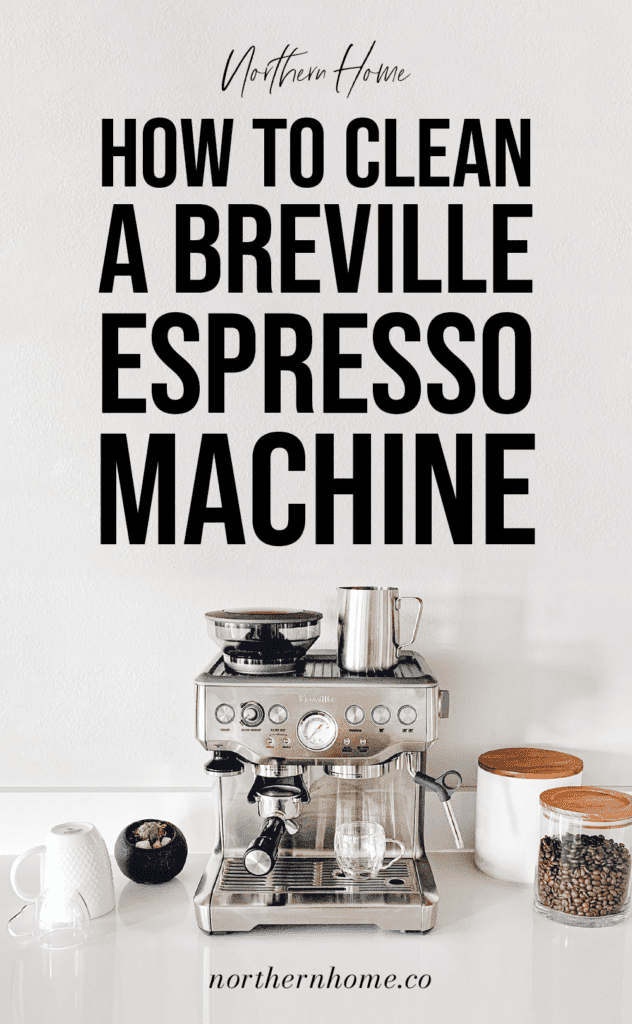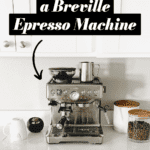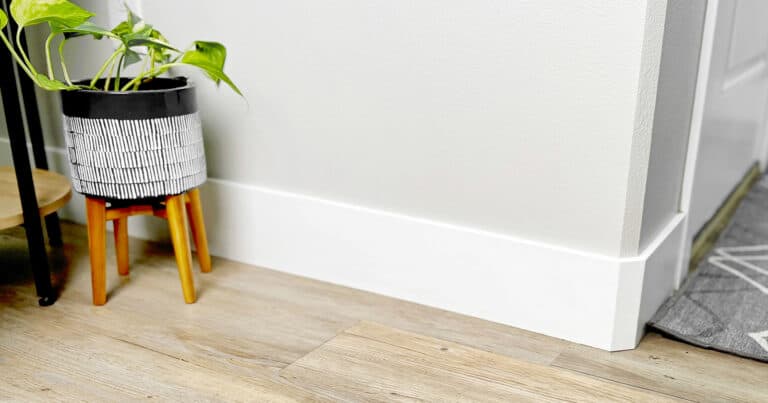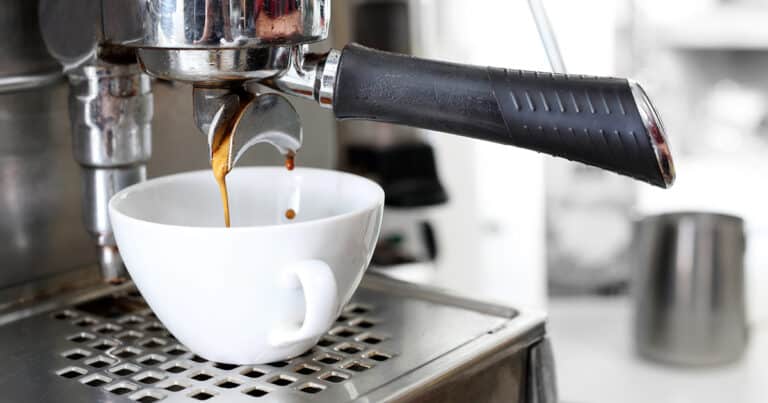How to Clean a Breville Espresso Machine
A simple guide on how to clean your Breveill espresso machine, including information about descaling, cleaning products you can use, and a recommended cleaning schedule.
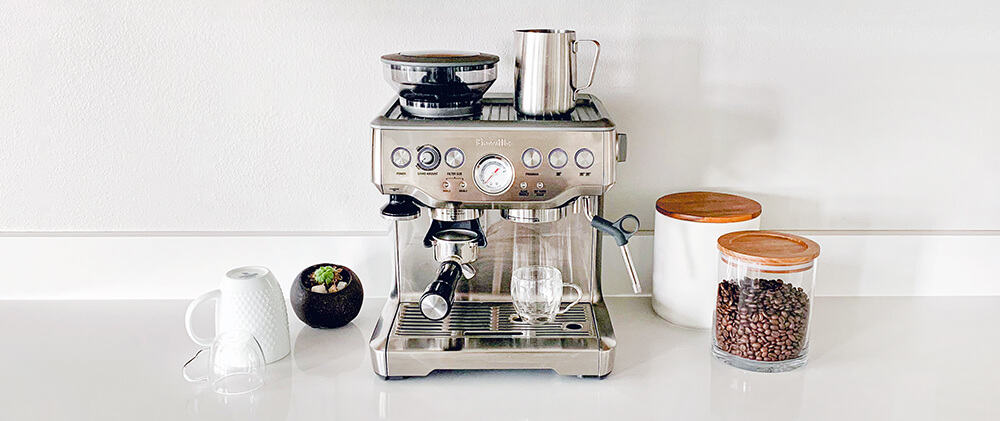
Here is a guide on how to clean a Breville Espresso Machine, an essential task if you want to prolong the life of your unit and keep your coffee tasting its absolute best.
However, it can be overwhelming to learn how to maintain your espresso maker. Many people don’t know how to do it properly and don’t realize just how easy it is.
This article will walk you through the entire process step-by-step. We will also give you some tips on what cleaning products and tools work best to make the job easier.
Find What You’re Looking for:
This post contains affiliate links. That means if you click and buy, we may receive a small commission (at zero cost to you). Please see our full disclosure policy for details.
There are two essential tasks you’ll want to learn about: 1) descaling and 2) the cleaning cycle. They perform different functions, and some people may confuse the two. We’ll go over them in detail, along with cleaning the smaller components of your espresso machine.
How to Descale Breville Espresso Machine
Let’s discuss the importance of descaling your machine, what solutions to use, and how to perform the process itself.
What is descaling?
Descaling is the process of removing scale — mineralized water — from the inner workings of your espresso machine, including the boiler. This issue is most problematic if you use hard water, although it’s still present in soft water, as well.
If not addressed, the buildup of scale will eventually affect the functionality of your espresso machine, regardless of the brand. You should periodically perform descaling on your Breville to keep your coffee tasting great. Moreso, descaling will ensure optimal performance and longevity.
What can I use to descale my Breville Espresso Machine?
There are a variety of products you can use to descale espresso machines. However, you want to ensure that whatever you’re using is safe for your Breville Espresso Machine. Your best bet is to order cleaning powder or solution directly from the manufacturer, if possible.
If you need to descale your Breville now and can’t wait, you have some alternative cleaning solution options that are both safe and effective.
Descaling Powder or Solution
If you’re looking for the fastest and easiest way to descale your Breville, descaling powders or ready-made solutions are the way to go. Made for descaling and ready to use with little effort.
Benefits of descaling powder or solution:
- Made for descaling
- Easy to use and store on hand
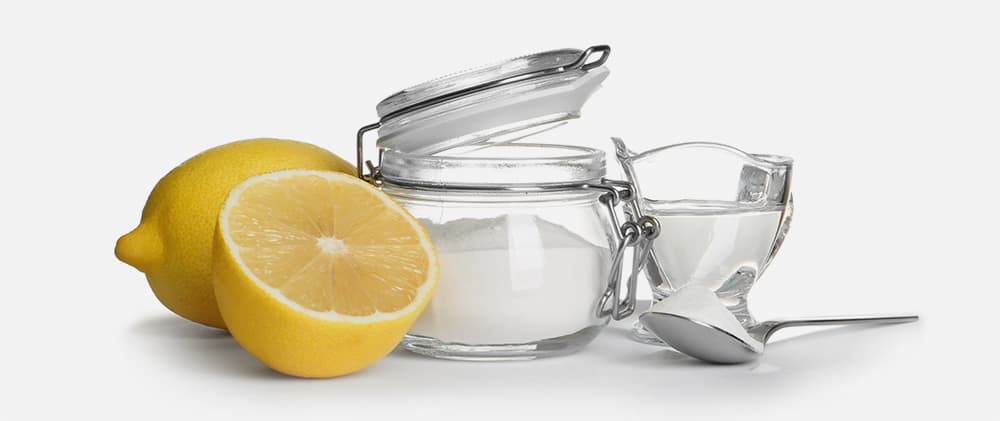
Vinegar
Vinegar is a common descaling option that is very effective. After all, vinegar is very acidic and has seemingly endless benefits and uses, so it’s no wonder it works as a descaler. Just be sure to rinse thoroughly because of its acidic nature.
This one is straightforward, too, as you just need to use 1 cup of white vinegar for every cup of water (filtered if available) until your Breville’s water tank is full.
Benefits of vinegar:
- Low cost
- Very acidic and effective
- Readily available
Lemon
Lemons are acidic and will undoubtedly serve you well as a descaler. You don’t have to worry about powerful odors, and lemons are very affordable.
If you have fresh lemons on hand, you can freshly squeeze the lemon juice. Otherwise, prepackaged lemon juice is equally inexpensive and works just as well.
To use lemon juice as a descaling solution, mix 1/3 of it with 2/3 water and run it through your Breville Espresso machine a few times. Then, run plain water through until you can no longer smell lemon.
Benefits of lemon:
- Low cost
- Natural
- Readily available
- Pleasant odor
Citric Acid
Citric acid is another popular descaling solution that is tried & true and highly efficient. Not only is it cheap, but it’s also odorless. Citric acid doesn’t leave behind any chemical residue, making for an excellent descaling option.
To complete the procedure, you’ll need 1 liter of water and two tablespoons of citric acid (you want to ensure it is food grade). Mix the ingredients and pour them into your water tank.
Benefits of citric acid:
- Easy to find
- Little to no odor
- Less acidic, easy to flush out
Baking Soda—Use Caution for Descaling
Baking soda isn’t completely water-soluble, meaning it won’t dissolve. This may cause unwanted issues with your machine, such as clogging or shutting it down. Although some still use it for descaling with success.
Its best use for cleaning espresso machines is as an exterior cleaner and getting the removable components clean.
Benefits of baking soda:
- Low cost
- Little to no odor
- Readily available in your pantry
You don’t have to use the exact descaling solutions every time. Test out a few until you find one that’s affordable and easy for you to use.
How to Descale Your Machine
Depending on the hardness of your water, you may need to descale more often than others. We recommend descaling every three months. If you use filtered water, you may stretch it to every six to nine months.
Fortunately, this cleaning process is quick and easy.
To start the descaling process:
- Begin by emptying the water tank.
- Be sure to remove the filter; you don’t want your cleaning solution getting in the filter.
- Fill the water tank with your choice of descaling solution, as discussed above.
- Set the filled water tank back in place.
- If your machine has a descale light: put your device into descaling mode by pressing the ‘2 Cup’ button and power button (may vary per model). The descale light should turn on.
- Press the ‘1 Cup’ button and be sure to have a container ready to catch the liquid.
- Wait 15 to 30 minutes for the first cup to work on the interior of the machine.
- Repeat by pressing the ‘1 Cup’ button again until you’ve used 2/3 of the solution.
- Point your steam wand in a separate container and use the rest of the solution in the tank.
- Empty any solution remaining in the tank.
- Thoroughly wash out the water tank several times to get rid of any remaining residue.
- Repeat the process with clean water to flush out the machine.
- Replace the water filter, fill up the water tank, and put the tank back in place.
- Power down and then power back on to turn off the descale light, if applicable.
You may need to repeat the final water extraction steps to ensure that all chemicals are flushed out.
Pro tip: use the clean flushed hot water to clean the portafilter while you wait. Cafiza is an excellent cleaning powder to add to help eliminate oils and residue.
UNIVERSALLY COMPATIBLE DESCALER – This product can be used to descale Keurig machines, as well as Nespresso, Breville, Jura, Delonghi and other drip coffee makers, espresso machines, superautomatics, and kettles
How to Perform the Cleaning Cycle – Clean Me
The cleaning cycle cleans the upper inner workings of your espresso machine. Not the entire set of internal components, not the boiler. It’s cleaning the group head and components leading to the drain solenoid valve in the bottom back right corner of the machine, accessible when you remove the lower tray.
Breville machines are designed to dry the puck and have pressure that pulls water back through the machine to the drain valve—sometimes bringing grinds with it that need to be flushed out.
When it’s time to clean your Breville, your unit should alert you when ‘Clean Me’ blinks.
- First, empty cycle your Breville to help flush out any beans/debris.
- Fill the water tank with water.
- Place a single cup filter inside the portafilter, then add the cleaning disc (included with your Breville machine).
- In the center of the disc, place a cleaning tablet.
- Attach the group head.
- Hold down the ‘Power,’ ‘1 Cup,’ and ‘2 Cup’ buttons at the same time until you see the cleaning light flash.
- This will start the ‘Clean Me’ cycle. Let go of the buttons and allow the unit to run through its cycle until the backflow cycle completes.
- Repeat steps 6 and 7 until your cleaning tablet is gone (or mostly dissolved).
- Run a single empty cycle to help flush out any leftover liquids/solutions from the group head, steam wand, and water dispenser. Repeat if necessary.
- Empty your tray of water and clean.
Breville Espresso Cleaning Tablets (8 pack), BEC250
Precision dissolution time to provide optimal cleaning performance
Breville recently changed their cleaning disc to a solid piece with no hole. So you won’t have water flowing through the portafilter unless you have an older version that still has the hole included. The water will escape through the drain valve into the drip tray.
Other Machine Components
Now that we’ve discussed the two major cleaning processes, let’s not forget about the smaller components that need upkeep as well.
Group Head
The group head is the portion of the machine that the portafilter goes into. It’s vital to clean so your espresso doesn’t taste like bad coffee.
Use an allen wrench (provided with Barista Express model) to unscrew the group head and remove it. You’ll notice a lot of coffee residual.
Use hot water and a cleaning powder (such as Cafiza or baking soda). Then wipe down with a clean cloth and put it back in place by screwing it back in with the allen key.
When you flush water through, it should be clear with no odor.
Portafilter Cleaning
The portafilter collects coffee bean oils and can clog up performance if not attended to periodically. To clean the portafilter, begin by removing the basket.
Soak the portafilter and basket (not the handle) in a combination of boiling hot water and cleaning powder (such as Cafiza or baking soda). Do this for 15 to 20 minutes and wipe off any remaining residue with a clean cloth. Rinse well with hot water.
Once completed, replace the basket and portafilter.
Grinder / Conical Burr
The bean grinder collects a lot of oils. If not cleaned periodically, the oils will gum up the grinder and hinder performance. Using the grinder tool discussed above or another type of brush, you can clean off oil residue using baking soda.
- Start by running the grinder to remove any remaining beans or grounds.
- Then remove the top of the grinder, turning to unlock, and remove the hopper.
- Use your vacuum to remove grounds in and around the hopper.
- Remove the top conical bur (contains a jagged edge that grinds the coffee beans) and use a brush to clean and wipe down.
- Replace all components and lid.
Steam Wand
Because the steam wand can develop mold, it’s essential to give extra attention to the frequency in which you clean your Breville Espresso machine parts. You want to give it a good flush after every use.
Every use cleaning:
- To do this, point the wand into the drip tray and switch your Breville’s dial to “Steam.” This will effectively clear out the tube.
- Then, you want to place your Breville in “standby” mode so that it can cool down. Once cooled, give the steam wand a good wipe down.
Deep cleaning:
- Use the ‘1 Cup’ button to make a cup of hot water.
- Transfer the hot water to the milk jug.
- Add steam wand cleaner.
- Remove the tip of the steam wand (if removeable).
- Add the tip to the milk jug.
- Place the wand in the milk jug.
- Soak for 15 to 20 minutes.
- Wash the tip of the steam wand.
- Replace the tip on the steam wand.
- Activate your steam wand for 15 seconds.
- Let it soak for 5 minutes.
- Remove the milk jug and activate the steam several times to flush the cleaning solution.
- Dump out the solution from the milk jug and replace it with clean water.
- Remove the tip and soak in clean water.
- Rinse the steam wand in clean water.
- Remove any blockage from steam holes with the tool provided by Breville.
- Replace all parts and steam again several times.
Outer Housing/Warming Plate
As discussed earlier, baking soda works wonders to clean the exterior of your Breville Espresso Machine. With your unit turned off and cooled down, use a mixture of baking soda and water (paste) to clean the outer housing and warming plate. Or your preferred cleaning product.
Drip Tray
As with the steam wand, your drip tray is prime real estate for mold growth. You want to clean it more often than other components. To do this, slide out the “Empty Me!” tab and dump the contents of the drip tray.
Finish it off by rinsing and scrubbing the drip tray to ensure that you eliminate all residue.
Storage Tray
The storage tray doesn’t need to be cleaned as often as other components, but it’s still a good idea to rinse it out occasionally.
Replace Water Filters
You should change your water filter every 3 months. This piece is a breeze to remove and replace and ensures that your coffee tastes its best.
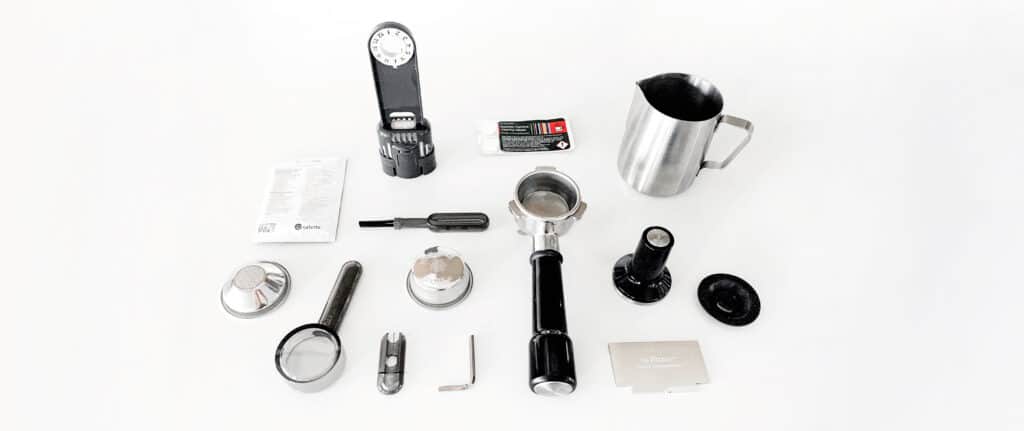
Cleaning Tools & Accessories
Some machines will come with a cleaning kit or cleaning tools. Be sure to check what they include with your espresso machine.
- Cleaning brushes (various sizes)
- Cleaning tool (to clear steam holes)
- Cleaning sponges
- Cleaning cycle disc (should be included with your machine)
- Cleaning cloths
- Vacuum (when cleaning grinder)
- Allen key (should be included with your machine)
- Descaling solutions or powders
- Cleaning tablets
You don’t necessarily need all of these items, but you’ll have a much easier time keeping your Breville clean with their aid.
When to Clean Your Breville
For optimal performance, clean your Breville regularly. But depending on your usage, you may not need to clean as often.
‘Clean Me’ Maintenance Indicator
When you notice “Clean Me” light up, you know it’s time to perform the cleaning cycle. A solid light typically means it’s time to descale, while a blinking light means it is time for the ‘clean me cleaning cycle.’
You can find this indicator on models like the Barista Express and the Infuser.
Cleaning Schedule
As not all cleaning tasks are prompted by the machine itself, you’ll need to set a cleaning schedule to follow. Here is a recommended plan that works for us, but you can adjust it based on how often you use your machine, whether or not you use filtered water, and what works best for you.
The most important thing is that you clean it regularly.
| Component | Each Use | Weekly | Monthly | 2 Months | 3-6 Months |
| Descale* | X | ||||
| Clean Me Cycle* | X | ||||
| Group Head | X | ||||
| Steam Wand Deep Clean | X | ||||
| Outer Housing/Warming Plate | X | ||||
| Grinder/Conical Burr | X | ||||
| Portafilter/Filter Basket Deep Clean | X | ||||
| Drip Tray | X | ||||
| Steam Wand Flush | X | ||||
| Portafilter Flush | X | ||||
| Replace Water Filter | X | ||||
| Storage Tray | X |
- 3-6 Months: descale and clean storage tray
- 2 Months: replace water filter
- 1 Month: clean me cycle, group head, steam wand deep clean, outer housing/warming plate, grinder and conical burr
- Weekly: Portafilter/filter basket deep clean, drip tray
- Each use: portafilter flush, steam wand flush
FAQs About Cleaning Your Breville Espresso Machine
Here are answers to commonly asked questions related to cleaning your Breville machine.
Why clean your Breville?
After so many uses, water mineralizes and causes debris to accumulate in your Breville. If left unchecked, your coffee will start to taste rancid, and your unit’s performance will suffer.
How do you flush a Breville coffee machine?
Simply press the “2 Cup” button. Doing this runs hot water through the unit’s group head for about half a minute. You then want to activate the steam function for about 10 seconds. Keep doing this cycle until your Breville’s water tank is empty.
How do you clean Breville with vinegar?
Run 1 cup of vinegar for every cup of water through your Breville’s water tank. You’ll need to run more than one clean water cycle to ensure that all vinegar residue is gone.
What happens if you don’t descale your Breville machine?
Mineralized water (limescale) will build up and hinder the performance of your machine. Also, coffee will taste rancid. Regularly descaling your Breville will prolong its lifespan and ensure that coffee always tastes fresh.
Read more about espresso machines
Final Thoughts
Cleaning your Breville Espresso maker is an essential task if you want to prolong the life of your unit and keep your coffee tasting delicious. Using the tips and tools in this guide will make your life much easier and speed up the cleaning process.
Pin for later
